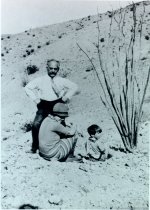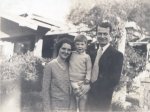
Early Career at the California Institute of Technology (1927-1930)
1927
As Assistant Professor of Theoretical Chemistry, Pauling gives lectures to CIT students on wave mechanics with chemical applications. He does research on the hydrogen molecule and the hydrogen molecule-ion.
Pauling translates Goudsmit’s dissertation into English, and he and Goudsmit begin enlarging it into a monograph, tentatively titled "The Atomic Model and the Structure of Line Spectra."
1928
Pauling returns to publishing papers on crystal structures, for example, brookite (with J. Holmes Sturdivant) and topaz.
He publishes a short article in the Proceedings of the National Academy of Sciences (PNAS) in which he proposes a general way of using the mixing of quantum mechanical atomic orbitals to explain the four valence bonds of carbon compounds (he writes that this can be done through "changed quantization"). As a result of the resonance phenomenon, a tetrahedral arrangement of the four bonds of the quadrivalent carbon atom is the stable one.
Pauling begins publishing papers on his coordination theory of the structure of ionic crystals.
Thomas Hunt Morgan comes to CIT, and he and Albert Tyler get Pauling interested in the complex molecules present in living things. Pauling becomes particularly fascinated by the question of biological specificity.
During the winter of 1928-1929, Arnold Sommerfeld is a visiting professor at CIT.
1929
In February, Pauling, as visiting lecturer in physics and chemistry, begins five years of formal association with the University of California in Berkeley. He teaches two courses: "Quantum Mechanics with Chemical Applications" and "The Sizes of Ions and Other Ionic Properties."
Pauling is offered a professorship of physical chemistry at Harvard University (this post, which had been previously occupied by Theodore W. Richards, who died in April of 1928, was offered first to G.N. Lewis, then to Tolman, and, when they both refused, to Pauling). After a trip to Harvard to investigate what his career would be like there, he, too, refuses the position.
In the fall, Pauling applies his coordination theory to various silicate minerals. By Christmas, he has determined the structures of talc, pyrophillite, the micas, and the brittle micas.
1930
Linus Pauling and Samuel Goudsmit publish The Structure of Line Spectra, Pauling’s first book.
After spending his usual term at Berkeley, Pauling returns to Pasadena on April 13, when he and his wife make preparations for a trip to Europe. After trips to Chicago and Washington, they arrive in New York on May 1. They spend the first week of May crossing the Atlantic Ocean, arriving in London on May 8. Pauling then spends several weeks in Manchester in the laboratory of William Lawrence Bragg, but he is disappointed because he has little contact with Bragg, he is never asked to present a seminar on his work, and he learns little except how to operate a Bragg X-ray spectrometer.
In July, he works on quantum mechanics at Sommerfeld’s Institute for Theoretical Physics. He visits Herman Mark in his laboratory at Ludwigshafen, about 170 miles northwest of Munich. Mark shows him the apparatus that he has been using to determine the structures of gas molecules by the diffraction of electrons. Pauling asks Mark if he has any objection to CIT’s making use of the technique, and Mark says no, that in fact he is not planning to continue his work in this field.
In the fall, when he returns to Pasadena, Pauling asks a new graduate student, Lawrence O. Brockway, to construct an electron-diffraction apparatus, which he does. The technique is first used to verify the structure and determine the bond lengths for the hexafluorides of sulfur, selenium, and tellurium. Then Pauling makes use of the electron-diffraction technique, with Brockway and several other collaborators (especially Verner Schomaker), to determine the structures of many substances (in the 1930’s, 1940’s, and 1950’s, over two hundred molecular structures are determined by means of this technique at CIT).
In December, Pauling resolves the problem that has been plaguing him concerning the quantum mechanics of the chemical bond. By assuming that the radial parts of different wave functions of the carbon atom are not very different, he is able to sufficiently simplify the quantum mechanical equations to show that the best bond orbitals that the carbon atom can form are oriented at 109.47 degrees with each other (the tetrahedral angle). He spends all night developing the calculations that extend his technique (later called the hybridization of bond orbitals) to other molecules.
Table of Contents
- The Ancestry of Linus Pauling (The Paulings)
- The Ancestry of Linus Pauling (The Darlings)
- Linus Pauling's Childhood (1901-1910)
- Linus Pauling's Adolescence (1910-1917)
- Pauling's Years as an Undergraduate at Oregon Agricultural College, Part 1 (1917-1919)
- Pauling's Years as an Undergraduate at Oregon Agricultural College, Part 2 (1919-1922)
- Linus Pauling as a Graduate and Postdoctoral Student at the California Institute of Technology, Part 1 (1922-1923)
- Linus Pauling as a Graduate and Postdoctoral Student at the California Institute of Technology, Part 2 (1924-1926)
- A Guggenheim Fellow in Europe during the Golden Years of Physics (1926-1927)
- Early Career at the California Institute of Technology (1927-1930)
- Pauling's Great Years of Achievement in Structural Chemistry, Part 1 (1931-1932)
- Pauling's Great Years of Achievement in Structural Chemistry, Part 2 (1933-1935)
- Pauling's Increasing Involvement in Molecular Biology (1936-1939)
- The War Years, Part 1 (1940-1942)
- The War Years, Part 2 (1943-1945)
- The Postwar Years, Part 1 (1946-1947)
- The Postwar Years, Part 2 (1948-1949)
- Proteins, Passports, and the Prize (1950-1954)
- Increasing Involvement in World Peace, Part 1 (1955-1958)
- Increasing Involvement in World Peace, Part 2 (1959-1963)
- The Center for the Study of Democratic Institutions (1964-1967)
- The University of California, San Diego (1968-1969)
- Stanford University (1969-1972)
- An Institute for Science and Orthomolecular Medicine, Part 1 (1973-1977)
- An Institute for Science and Orthomolecular Medicine, Part 2 (1978-1981)
- The Years Alone: Pauling after the Death of Ava Helen, Part 1 (1982-1988)
- The Years Alone: Pauling after the Death of Ava Helen, Part 2 (1989-1994)
- About the Author



